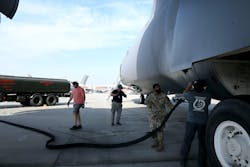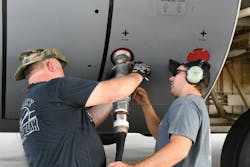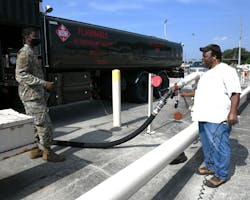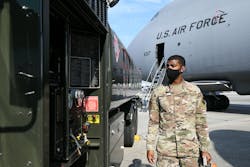The 78th Logistics Readiness Squadron’s Fuels Management Flight provides Robins Air Force Base with the fuel to fly and fight.
The Petroleum Oils and Lubricants team fulfills the fuel and cryogenic requirements for the 78th Air Base Wing and its mission partners.
“The 78th LRS Fuels Management Flight is one of the most unique emulsions of military and civilian employees working together as POLs,” said Walter Seth, 78th LRS Fuels Management Flight chief. “Hiring veterans, retired military and civilians gives us a workforce with more than 400 years of combined experience.”
Deshawn Carino, 78th LRS Fuels Management Flight Distribution Element distribution operator, said the team provides fueling and defueling operations.
“A fuel request will come in through the Maintenance Operations Center or Transient Alert, and coordination will be made as to where and how the fuel will be delivered,” Carino said. “We have the capabilities of doing both. We can use our fuel trucks or our hydrant system trucks.”
The flight has designated vehicles for each service provided.
“We maintain dedicated R-11 defuel trucks that are ready at all times,” Carino added. “Since Robins Air Force Base is known for having a depot mission, we have the second highest amount of defuel operations in the Air Force.”
The fuel must be filtered a minimum of two times to protect the integrity of the fuel as the aircraft is defueled and refueled.
“One defuel truck takes about an hour to remove fuel from an aircraft and return the fuel to bulk storage,” Carino said.
“Once the truck hits 5,000 gallons, during the defuel process, a person needs to monitor the tank on top of the truck to ensure the truck does not overflow. The dual-purpose R-11 fuel truck is capable of carrying approximately 6,000 gallons of fuel. It is capable of doing both defueling and refueling operations at different rates.”
The process for one driver can be time consuming but there is a quicker way to fuel aircraft, Carino explained.
“The hydrant system is an underground fuel system,” he said. “The system includes pumps, filter separators, pipes, and outlets. Fuel is supplied to all outlets through a loop of underground corrosion-resistant piping.”
The POLs Team provides more than three types of jet fuel.
“We also have four types of ground fuel, two types of gasoline, and two types of diesel,” Carino said. “We provide the liquid oxygen that allows aircrews and pilots to safely operate at high altitudes and the fuel that drives the Air Force mission.
“I feel like this is my piece of the puzzle and me answering my nation’s call. It’s my contribution to my country.”



